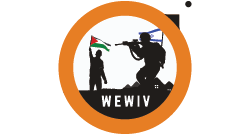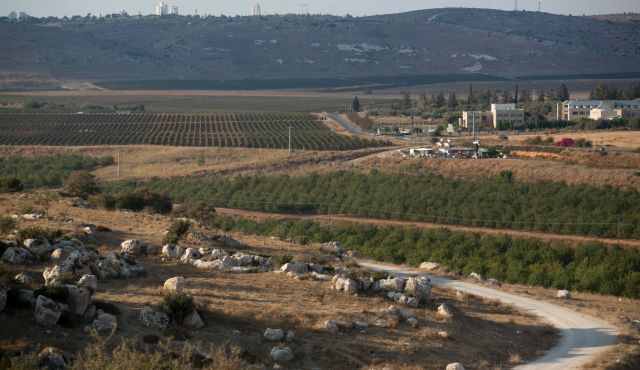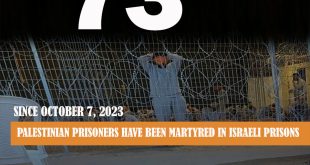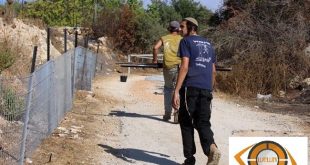Several rural communities in central Israel are working land located across the pre-1967 border that was improperly allocated to them by the Israel Lands Authority, Haaretz has learned. The Civil Administration has launched an investigation of the matter following a query from Haaretz.
The land – an estimated 15,000 dunams (375 acres), over which the ILA has no jurisdiction – is located near the settlement of Mevo Horon near the pre-1967 border. The communities which were given the land for cultivation are all moshavim in the Mateh Yehuda Regional Council, outside Jeruslaem. They include Mesilat Tzion, Even Sapir, Eshtaol, Taoz and Naham , which are all on the Israeli side of the border, also called the Green Line.
Members of the moshavim confirmed to Haaretz that they are working this land. “It’s true, but we have only 150 dunams [on the other side of the Green Line]. I got it like that, when I got here, so you have to ask the ILA,” an individual from Mesilat Tzion said. “They raise mainly non-irrigated crops there. I don’t know when it happened, it certainly was before I got here,” he added.
“We work with the ILA and under their supervision,” said a member of Moshav Naham, located near Beit Shemesh. “It’s from back in the ‘80s, it’s decades.”
Conversations with officials familiar with the details said the Authority allocated the land more than 30 years ago, but had no right to do so. But as far as the moshavim working the land are concerned, they are legally leasing the land.
Dr. Ronit Levine Schnur, of the Interdisciplinary Center, Herzliya, and a former legal consultant to the Civil Administration, said that one method of allocating the landwas to grant the World Zionist Organization permission to use it, since that organization is allowed to give it to any other entity to settle. “Whether it’s an illegal outpost or a community in Israel, it doesn’t matter,” she added.
Levine Schnur, who served as a Civil Administration consultant until about 2010, said she had seen documents showing that the Israel Lands Authority had allocated land near Mevo Horon. However, she could not confirm whether these are the same lands the moshavim were given. “It’s a very, very problematic location, the Latrun enclave, they may not have been precise about the [border] lines.”
Palestinians from three villages that existed in the Latrun area until the 1967 Six-Day War say the land is theirs, and that they have documents to prove it.
Dima Abu Gosh, from East Jerusalem, was born in the village of Imwas, which was demolished after the Six-Day War. Her father has official documents from the land registry office proving ownership of some of the land, she told Haaretz. “The other residents don’t want to go to the Israeli courts. We are discussing it, and we might want to do it in the future.”
Haider Abu Ghosh , who was a14-year-old resident of Imwas when the Six-
Day War broke out, says he remembers the land in question clearly. “The crops and some of the roads in the area are on land that was ours before 1967,” says Abu Ghosh.
According to anti-settlement activist Dror Etkes of Kerem Navot, an NGO that researches land ownership in the West Bank, there is no doubt the Palestinians own that land. “Aerial photos show that this land was worked by Palestinians who lived here before the villages were demolished. It’s not clear how the Israel Lands Authority got its hands on it,” Etkes said, “but it was clearly not in the Authority’s jurisdiction to hand it over to other entities.”
This is not the first time the Authority has acted beyond the scope of its powers, which are limited to the State of Israel within the Green Line. In 2013, the Authority conceded that it had given private Palestinian land in the north to Kibbutz Merav in the 1980s. The kibbutz, located on Mount Gilboa, worked the land until a few weeks ago, as reported in Haaretz. The kibbutz evacuated the area, incurring major economic damage, Merav’s business director told Haaretz. The land now lies unused, because the Palestinians who claim to own it are on the other side of the separation barrier and have no access to it.
The Mateh Yehuda Regional Council said: “Each community has a lease contract with the Israel Lands Authority, which is the body responsible for this matter.” The Israel Lands Authority did not respond for this report.

 العربية
العربية עברית
עברית Türkiye
Türkiye Русский
Русский Français
Français We Watch Israeli Violations Specialized website in monitoring and documenting Israeli violations against Palestinians
We Watch Israeli Violations Specialized website in monitoring and documenting Israeli violations against Palestinians






